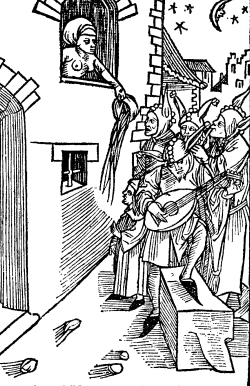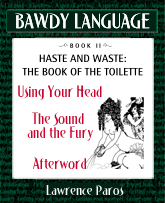Bawdy Language: Book Excerpts
As a public service, to advance the world's awareness and understanding of the origins of curse words, swear words, dirty talk, and sexual slang, and to whet your appetite for more, we offer for your pleasure a page from each chapter. These samplers provide a good sense of the subject matter of each chapter, each of which is self contained. They are cool both for reading and as a gift. Individual chapters can be downloaded at a mere $1.99 each. Such a bargain!
Using Your Head: Book II - Haste Makes Waste/ The Toilette 2
The Erotic Tongue
Haste Makes Waste: The Book of the TOILETTE

Ladies will please remove their hats during the performance.
— Wit and Wisdom from the W.C.


When all is said and done, most Americans need room to do it. Today's favorites include wash-rooms (c. 1878), bath-rooms (c. 1850s), from a time when the necessary fixtures joined the bath, and powder-rooms. The little girl's room (c. 1940s) is still with us today, though its counterpart, the little boy's room, is seldom referred to. Dual-room names continue to dominate the landscape of restaurants nationwide: His 'n' Hers, Gents and Ladies, Gulls and Buoys, Lads and Lassies, and Braves and Squaws (Ugh!).
Down and Dirty
Many prefer the restroom. But if you asked for it in England, your hosts would likely point out the cloak-room or show you to the bedroom. Perhaps you thought yourself couth by not asking for the toilet (c. 1820s-30s), or one of its mutant off-spring the toidy or toy-toy (20thC), but the toilet still works fine there among the working-class.The toilet derives from the French toilette, the diminutive of toile, the cloth once covering the table on which sat one's preparations, making it all very acceptable.
Drop Everything
The British middle-class, however, prefers the loo (early 20thC), though its origins remain somewhat of a mystery. Some think it derives from the cry "Gardez l'eau!" "Mind the water!" — a warning to look out below, supposedly from the days before modern plumbing when emptying chamber pots from upper-story buildings was a commonplace occurrence. Others suggest it is a misreading of room number 100, supposedly a common European toilet designation. Alas, the most popular designation there is "00" (zero, zero).
A more exotic theory traces it to Bourdaloue, a long-winded eighteenth-century Jesuit who ended up naming a china urine receptacle to be slipped between a woman's legs. So proper was the loue (the shortened version, popular during the 18th and 19thC) that it could even be used in public when the lady was wearing full skirts.
Have all these possible derivations only further muddied the waters? In lieu ("the place" and yet another possibility) of the loo, there's always the water-closet ( les water in France) dating from around 1755 when it first moved into the house from outside, most commonly referred to today as the WC (19thC).
237

